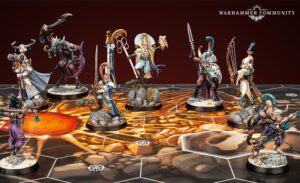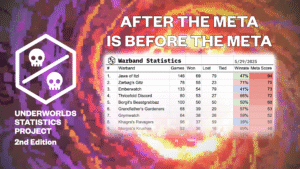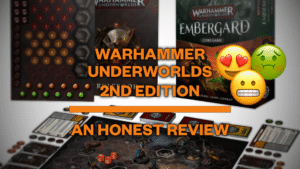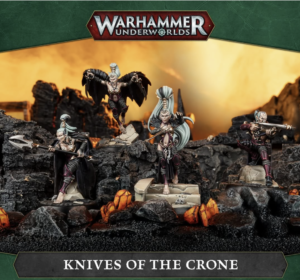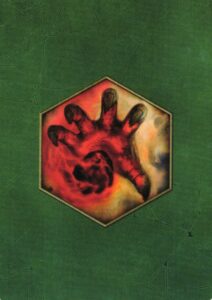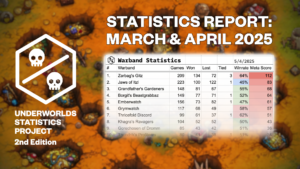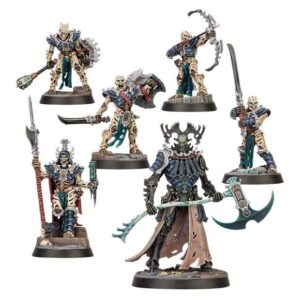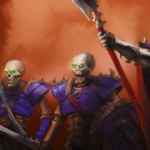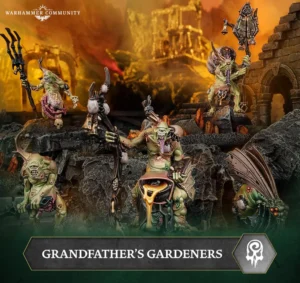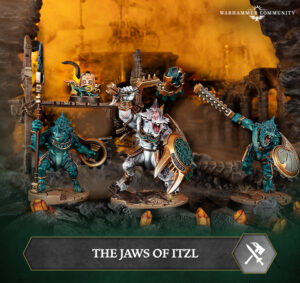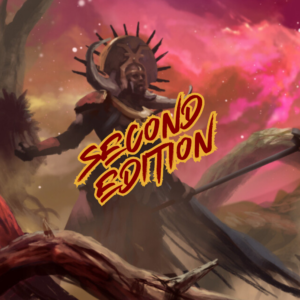
Intro
MARK: Welcome back to another article here on Path to Glory! Today is a new type of meta analysis article where I will not be diving into a warband but rather a Rivals deck. The focus for this one will be the Voidcursed Thralls Rivals deck (which I will abbreviate as “VCT”) and its current place in the meta. While this will mostly be focused on Nemesis, which I know is rare for my content, I think some of the points extend to Championship as well. The impact of the Rivals deck itself is just felt more strongly when you play Nemesis, so it seemed the more fitting platform for the discussion. Anyway, I basically just wanted to gush about how awesome this deck is and all the fun things you can do with it. In a hilariously meta-thematic way, pretty much everyone I talk to who plays the types of warbands that synergize with VCT can’t seem to get enough of it and, much like “voidcursed thralls” would do, continue to spread the word of how much fun it is to use. I suppose it’s possible that’s been a bit of a local meta thing, as, to my knowledge, the deck only made up about 13% of the field (4 out of 31 entrants) at NOVA and a lot of my opponents seemed surprised by the matchup. That being said, I genuinely think that, unless you intend to play one of the very top-tier Nemesis meta threats right now (mostly Pandaemonium), this is the deck that gives the largest number of warbands the best chance of winning against those top-tier guys. I want to clarify that this is not going to be a recap of my experience at NOVA (make sure to check the podcast for that episode coming soon), but rather a summary of the VCT deck as I understand it. I’ll go over why I think it’s so impactful, as well as a few tips and tricks to keep in mind both when using the deck and when playing against it. I’ve also brought in George to help me out with this, so his thoughts are also reflected in the content of the article. Let’s break it down!
Strengths of the Deck
I will touch on these things individually, but one of the major advantages of the deck, compared to other Nemesis pairings, is that there are simply good cards in the deck across the board. Solid surges, very good end phases, a wealth of strong gambits, and a few really powerful upgrades. You’ve got ping, accuracy, defensive buffs, out-of-sequence moves/attacks, control tools, and a plot card that has a significant gameplay impact. Many, if not all, of the other decks tend to have a spot where they are lacking critical supplementary cards to generate a cohesive pairing with a warband’s faction weaknesses.
Starting off with the impact of voidcurse, I don’t think there’s a Rivals deck that offers you stronger options with respect to enemy control tools in the current meta. You might argue Toxic Terrors has the edge given [![]() Freezing Venom]
Freezing Venom]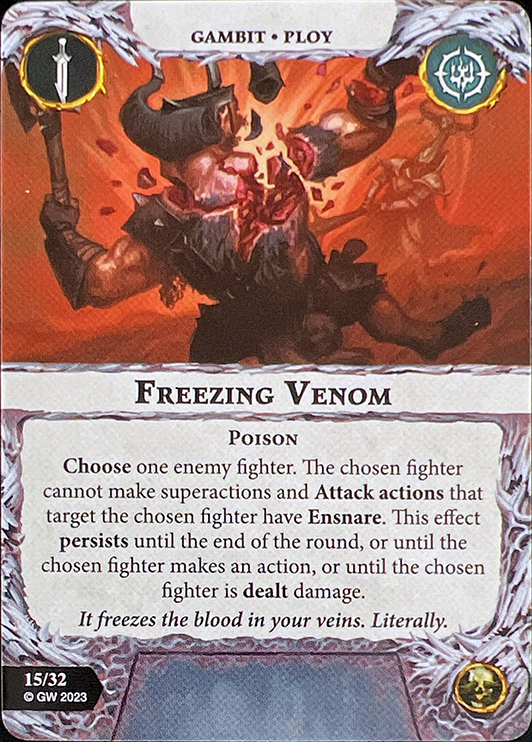 , [
, [![]() Ill-prepared]
Ill-prepared]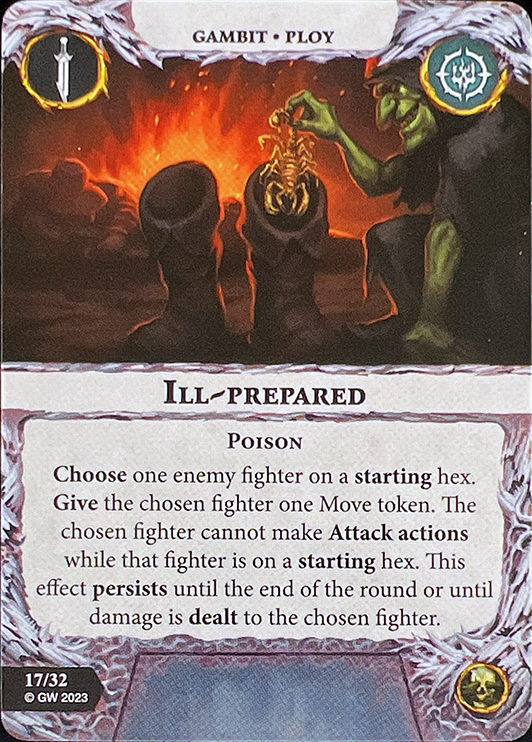 , and [
, and [![]() No Safe Ground]
No Safe Ground]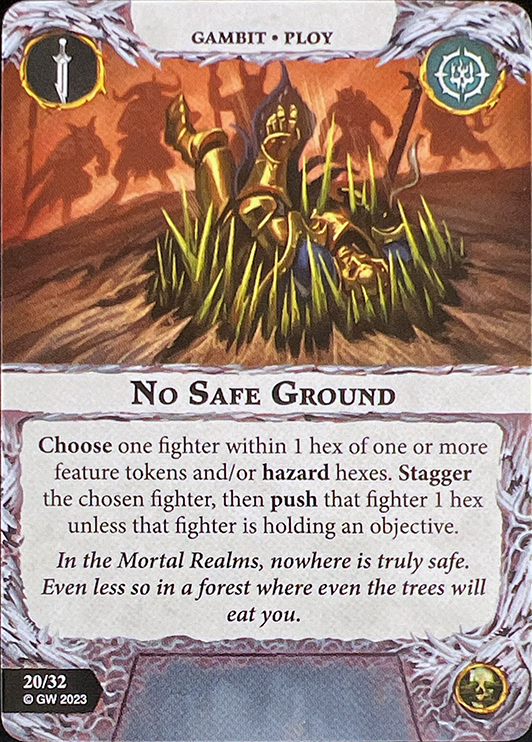 , but none of these are as singularly debilitating to specific fighters as voidcurse itself is. Taking Ephilim again as our example, voidcursing them means they, for the remainder of the game, can no longer make their spell attack action, cannot use [
, but none of these are as singularly debilitating to specific fighters as voidcurse itself is. Taking Ephilim again as our example, voidcursing them means they, for the remainder of the game, can no longer make their spell attack action, cannot use [![]() The Fires of Change]
The Fires of Change]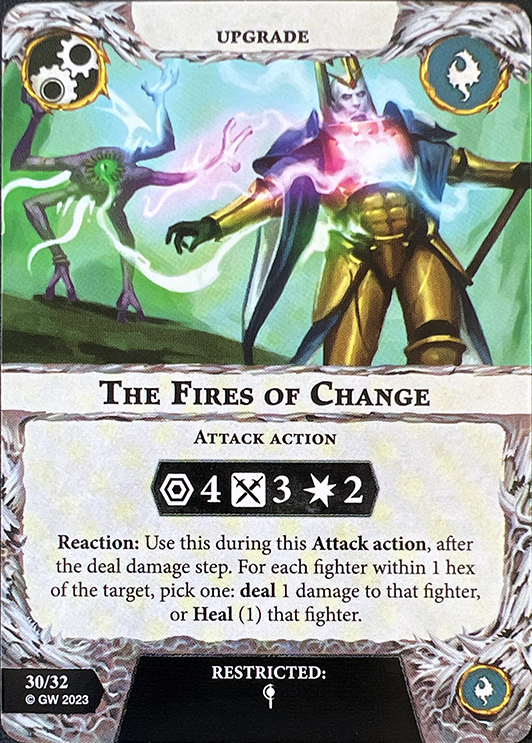 , have their defence characteristic dropped from 2 Dodge to 1 Shield, and, of course, cannot make actions besides move, attack, or charge (this nullifies the potential to make guard actions or use cards like [
, have their defence characteristic dropped from 2 Dodge to 1 Shield, and, of course, cannot make actions besides move, attack, or charge (this nullifies the potential to make guard actions or use cards like [![]() Quintok’s Unseen Hand]
Quintok’s Unseen Hand]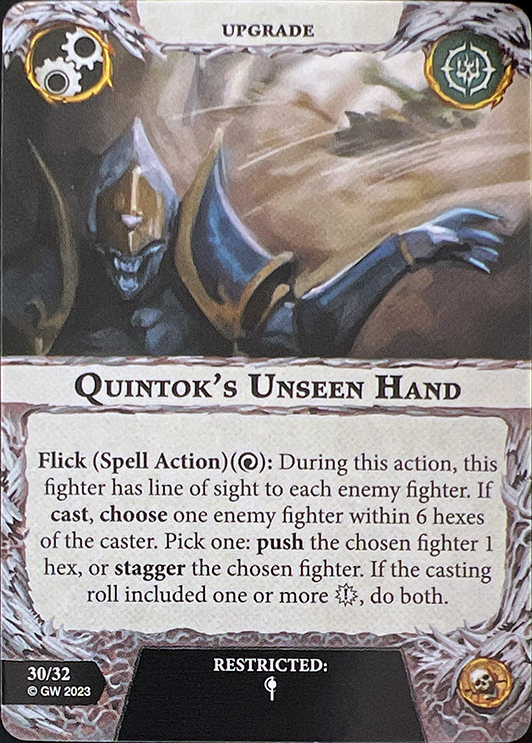 , for example). On top of the cards that spread the curse, Involuntary Advance can be used as a [
, for example). On top of the cards that spread the curse, Involuntary Advance can be used as a [![]() Distraction]
Distraction]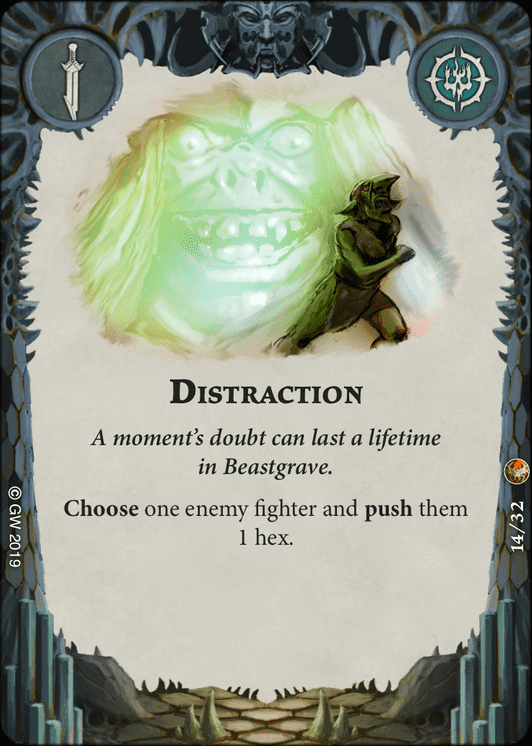 , when needed, no proximity required so long as the target is cursed. Furthermore, the positive effect of preventing driveback on your own fighters allows you to hold selected board positions more effectively, particularly by occupying a critical objective token your opponent likely wants for themselves, which is especially impactful given the general scarcity of enemy pushes in the Nemesis format.
, when needed, no proximity required so long as the target is cursed. Furthermore, the positive effect of preventing driveback on your own fighters allows you to hold selected board positions more effectively, particularly by occupying a critical objective token your opponent likely wants for themselves, which is especially impactful given the general scarcity of enemy pushes in the Nemesis format.
GEORGE: I’d like to give some special attention to the utility that voidcurse offers for warbands with baseline or reliable faction access to cleave. For those going against an opponent who brings VCT, pay special attention to their fighters who have or could be given cleave.
MARK: Looking at objectives, there are a remarkable number of cards that you can score with minimal interaction and/or even score when your opponent does something. Even if you and your opponent never interacted over the course of the match (i.e., never moved beyond no one’s territory and never attacked), you could still score 5 of the 12 objectives, with potential for that number increasing to 6 or 7 depending on card draw and matchup. Once you start factoring in some of the cards which do require interaction, your opponent could very well be scoring them for you. The ability to watch them kill your fighters and think to yourself that it’s all going according to plan is a luxury not afforded to many warbands in Nemesis. This is most prominently reflected in the interaction of Reshaping Demise with Surrendered Will and Involuntary Interdiction, as a single adjacent charge and kill on one of your fighters may give your opponent glory, but can also potentially get your ball rolling at the same time. Of course, this also opens a further safety net of Uncounted Cost, which you should score even in games where you get tabled (short of drawing it R1 and having to discard it).
Lastly, but perhaps most importantly, the out-of-sequence movement in the deck is far beyond any of the other universal decks to date. This comes down to, in particular, three cards: Forced Movements, Refashioned Reactions, and Refashioned Priorities. Assuming you are able to play all three over the course of a match, that is an additional 3 to 7 move actions (plus any warband-specific move actions you might trigger) in a game. Setting aside for a moment the massive activation efficiency upgrade this offers compared to other decks, the manner in which you can use these movements to surprise your opponents also provides immense value. You can move a fighter who has charged and abuse the new charge rule to catch your opponent off guard toward the end of the round, extend the threat range of a fighter who has already moved (and therefore cannot charge, in most cases), or even chain the movement reactions to outmaneuver an opponent’s charge for a devastating waste of their activation. The combination of the move reaction upgrades and negation of driveback also synergizes incredibly well with the new direction of positional surges scoring after opponent’s activations, making these two upgrades extraordinarily unique and attractive pieces to consider.
GEORGE: A special note for VCT in champ or with warbands that have “after an opponent’s activation” scoring windows in their surges, but “after an activation” surges can be revealed for scoring both before reactions to the end of an activation, AND after – depending on when the condition is met. A common example would be scoring a surge for holding an objective after an activation both before you push off it with Duellist’s Speed, or after you push onto it. Refashioned Reactions/Priorities can let you steal surges such as Held In A Bloody Fist or Hanging On with less lead time than is normally expected.
How Might My Opponent Voidcurse My Fighters?
MARK: There are exactly 6 cards (4 gambits and 2 upgrades) a VCT player may use to curse their opponent’s fighters:
- Reshaping Snare is the biggest one to watch out for, as there is no range limitation. Don’t leave any particularly voidcurse-vulnerable fighters on an objective token until you’ve seen this card come out unless you’ve already done the math and decided you can win despite the curse. For example, there is zero reason your Deintalos should be walking onto and staying on an objective token in your first activation of the game against a VCT player.
- Reshaping Demise can be used any time you take one of their fighters out with an attack action, blasting the curse onto every fighter adjacent to the target. If you can’t risk this on a certain fighter or fighters, don’t take the bait when a guy charges into the midst of half your warband, simply charge out of adjacency and kill them from a safe distance or try to sequence it so that you kill the fighter with a gambit or lethal hex.
- Voidcursed Assault is a 1R/2H/1D attack that each of your opponent’s voidcursed fighters may make in a power step. This is one you don’t have quite as much agency to stop, but keeping out of range from your opponent’s cursed fighters is about the extent of positional denial opportunity you have here.
- The final gambit is Reshaping Burst. You have less control over this one, but, if possible, try to keep susceptible fighters outside of a 2-hex bubble from the nearest cursed fighter (friend or foe). The VCT player has a lot more control when exposing you to this one, but it also only has a 33% chance to hit any given fighter, so many will forgo it for that reason.
- Lastly are the upgrades, the more prominent of which is Singular Reshaping, which they may give you to upgrade one of your fighters instead of their own. The important things here are that you get to choose which of your fighters to give it to in this case and you are certainly able to upgrade a fighter who has already been cursed. While it has not been FAQ’d and they may decide it doesn’t work like this, one niche way to rid yourself of the curse is by breaking the upgrade with a card such as Launch an Attack.
- The other option is Thrallmaker, which allows them to curse you after the equipped fighter’s successful attack action. Again, you have a bit less control here, but the upgrade is telegraphed enough that you may be able to position your way out of the attack, although you may just be praying for the dice gods to smile on you and brick that fighter’s attack.
And that’s it. Those are the only ways your opponent could possibly spread the curse to your fighters. While you don’t have a ton of agency in some of them, it is important to deny them the freebies, particularly with respect to Reshaping Snare and Reshaping Demise.
General Tips and Tricks to “Counter” the Deck
- Know how you can get voidcursed – This is #1 and even got its own section in this article because it is that important. You need to know how they can screw your susceptible fighters over otherwise you can’t factor it into your decision tree.
- Keep an eye on who your opponent has voidcursed – In addition to needing to know which fighters you can or cannot drive back, you also need to keep an eye on these for the couple of cards that spread curse only from already cursed fighters. Additionally, they can only used Forced Movements on their cursed fighters, so do not discount a threat from a cursed fighter that is currently unable to get off an attack if they can still activate and your opponent has power cards in hand. Alternatively, slow playing the killing of these fighters can delay the Uncounted Cost If you can prevent either condition of that card through the second round, odds are you’re bricking their hand a bit unless they’ve been fortunate enough not to draw into the card to that point.
- Know which fighters have the move reactions (and whether they’ve used it this round) – Getting outmaneuvered has to be one of the worst feelings in the game, but there are often times where you could have charged into a slightly more optimal position to stop it from happening. The simplest counterplay is to charge adjacent to the fighter you are worried about scurrying away, but keep in mind that they can use one reaction to proc the other. If your fighter has range, ideally you charge into a spot where, even if one target is able to get away, there’s somebody else you can go for instead. For Range 1 guys, think hard about where their move reactions are allowed to terminate and see if there is a spot you can charge where they can’t screw you over. If this is not possible, try to find a more dependable activation instead.
- Always play like Threatening Presence is in your own deck – The VCT player will very likely be carrying this and, if they are, will likely be aiming to outpopulate you in their own and no one’s territory. If you aim to do the same to them and succeed, they will not score this on you. I made that sound way easier than it is in practice, but glory denial is important people!
As with most matchups, knowledge is at least half the battle. Knowing exactly what options your opponent might have is the best way for you to make optimal decisions. It can be hard to think about both what they are doing and what you are going for at the same time, but that aspect of the game is critical if you want to get better, even more so given the permanence of a single mistake against a VCT deck.
One of Us…One of Us…
Having written to this point in the article, I’m sorry to say that, while I do still recommend giving the deck a go, you’ve missed the best window to use it. What I mean by that is, as I stated earlier, I have observed a remarkable amount of unfamiliarity with what the VCT deck can do. This includes straight up not being familiar with the effect of being voidcursed itself (and its permanence), failing to identify all of the board states which could lead to me voidcursing an opponent’s fighters, and/or being caught off-guard by certain end phase scores or movement shenanigans. The cat is out of the bag now and people should all be caught up on what to expect when they sit across the table from it at this point. Gone are the days (hopefully) where you sit down at a table to use VCT and your opponent willingly moves their Ephilim onto an objective in their first activation without delving. They ought to know better by now. Similarly, if the deck continues to increase in popularity, you start to hit matchups where your opponent is intimately familiar with what you are trying to do because they are trying to do the exact same thing! In these cases, the “offensive” aspect of voidcursing enemy fighters will likely suffer as well, since your opponent would be using a warband which synergizes well with the effect anyway. This is not to say that you can’t still hit a very high skill ceiling while playing it, only that the competitive edge that early mastery of the deck afforded will be slightly dulled by a better-prepared (on average) opponent.
GEORGE: An interesting thing about the voidcursed deck is that it is very symmetrical when playing against itself. If one player is scoring an objective, oftentimes both players are. This means that while your deck gets more reliable as more opponents have VC, it also means that your win depends more and more on just your faction deck, dice, and bounty ceiling. Threatening Presence and Unwitting Guardians are the best asymmetrical objectives in the VCT deck, so in a mirror it will be imperative that you deny the opponent’s Threatening Presence and score your own. Similarly, if enough people start bringing Reshaped Realm, everyone somewhat has to keep up, as its quite hard to deny if you are also playing VCT.
That’s all for now. As always, thanks for reading and best of luck on YOUR Path to Glory!

